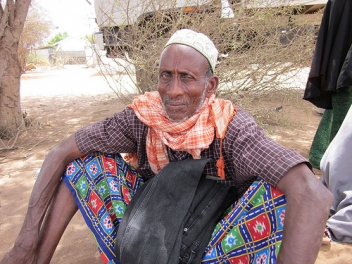Dadaab, the biggest refugee camp in the world… More than 400,000 people have fled their country to settle in this hot, sandy and windy place.
The month is August, it has not rained for months, and the only green to be seen comes from bushes and trees. I wonder how few cows are surviving, but I see some herds, as well as goats and sheep.
When the rain comes, it will turn most of the land into marshes and flood the temporary shelters that refugees have built outside the official camps…
No option but to leave their home behind
The influx of new arrivals from Somalia does not stop. They are fleeing the insecurity, but mostly, they could not stay in their homes any longer because of the persistent drought.
 Abdullahi, 70, has just been through the process of being tagged at Hagadera reception centre. A red plastic bracelet has been tied around his wrist, as a proof of his having been seen at the registration centre.
Abdullahi, 70, has just been through the process of being tagged at Hagadera reception centre. A red plastic bracelet has been tied around his wrist, as a proof of his having been seen at the registration centre.
This gives him access to a ration of food for three weeks (wheat flour, oil, corn meal, sugar, beans, CSB-corn soya blend- and salt), as well as a cooking kit, a blanket, a mat, a 10 litres jerrycan and soap.
Arriving from Somalia after 15 days of travel, he says, “I am one of the few lucky ones who were transported by a truck from the border to Dadaab. I used to live alone and work on my small piece of land. I have been a widower for seven years. My sons disappeared and my only daughter is married and looks after her own family. The drought took away my only means of livelihood, and I was forced to leave.”
Several months wait to receive food and shelter
Now he has to find a place to live, before being officially registered by the Directorate of Refugee Affairs (DRA – Government of Kenya) and UNHCR. The registration can take up to two months, and Abdullahi has only received food for three weeks…
Being registered allows refugees to have access to food distribution, and to be given an official plot with a tent, a real shelter. However, some refugees have to wait for several months before being allocated a definitive plot.
Daoud is a 75 year old who arrived in Dagahaley eight months ago. He is registered but still lives in what is called “the outskirts”, that is, outside the official camp. “I used to work as a farmer in Somalia, but the farm stopped being productive in the last five years. I was also a Coranic teacher, but had to stop because there was a lack of pupils. I decided to leave when I had no means to earn an income. I appreciate life in the camp. There is no war and no problem of food.”
In hope of a better life
There are currently around 13,000 older people in Dadaab camps, and the number is growing everyday. Some have arrived 20 years ago while others are new arrivals. Some are alone, some with families while others are the sole care providers for their family. They all have to adapt to harsh environmental conditions and heavy bureaucratic procedures. They are not used to the food rations and often cannot consume them, as they are too hard to chew. Being allotted shelter and a place to live is also uncertain.
They have made the choice to leave their home in the hope of a better life. And all we can try to do is make it easier for them…
HelpAge International will undertake a full nutritional survey of older people in the camps next month.
This will produce hard data that will be used to establish a nutrition project and for lobbying other agencies.
